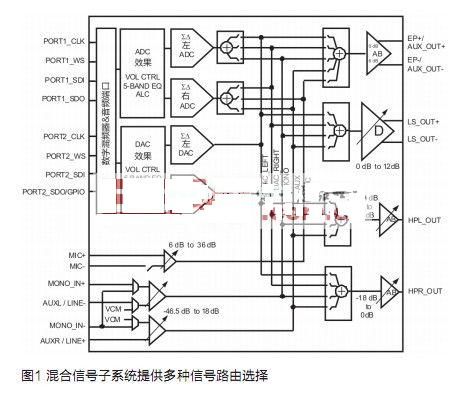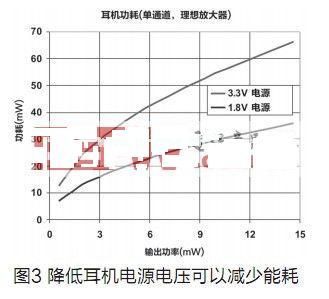introduction
This article refers to the address: http://
Feature phones, smartphones, PDAs and many other mobile-derived products are replacing many portable electronic devices. This combination of functions increases the audio requirements of the system while reducing the number of devices that consumers carry, and increases the burden on designers to solve audio problems.
As audio requirements increase, system designers can choose to use discrete audio function modules. However, this approach is used in mixed-signal systems for multi-line operations. In the digital world, providing multiple sample rates, formats, and digital levels can increase the complexity exponentially. In the analog world, signals are biased at different levels, mixing and switching, amplifying and attenuating, and easy to pick up noise. In fact, it is now common for portable media devices to have 10 to 20 different audio signal paths. Finding a path in this maze is a daunting task. The mixed-signal subsystem helps solve such problems by integrating multiple effective elements.
Signal routing
The most notable feature of the mixed-signal subsystem is its ability to route many signals to multiple locations. By using routing signals, portable media devices or mobile phones can perform many tasks. An example of a mixed-signal audio subsystem is shown in Figure 1.

For example, consider a system that has both a mobile phone and a digital audio player. The Pulse Code Modulation (PCM) digital signal from the baseband of the handset needs to be connected to a digital-to-analog converter (DAC), which in turn is connected to the headphone amplifier for use with the headset. The same headphone amplifier is also suitable for digital audio players, which is an I2S stream that is played through the DAC and then connected to the headphones. A mixed-signal subsystem with dual digital audio ports makes this task easy.
Another advantage of the multiplexed mixed-signal audio subsystem is the ability to process analog FM radio signals. Although FM radio signal levels are usually controlled, they often exceed specifications. These levels outside the specification are usually much larger than expected, which can cause speaker damage. The mixed-signal audio subsystem digitizes the FM signal, uses the DSP to provide automatic level control (ALC) and equalization, and then converts back to an analog signal for amplification to the speaker or earphone. In addition, the mixed-signal subsystem can pass the digitized signal to the baseband processor for more DSP processing.
In addition to audio routing and processing, the mixed-signal subsystem can also mix multiple audio streams. Sidetones are produced by mixing signals from the microphone into the headphones. Similarly, you can play a ringtone while listening to music without having to mute the music.
Having two digital audio ports makes the mixed-signal audio subsystem a powerful tool for connecting digital audio within the system. For example, an I2S digital audio stream can be converted to PCM and sent to baseband. Alternatively, the 48 kHz I2S interface data stream can be converted to a 44.1 kHz signal using the same method.
One application that benefits from dual digital audio ports and sample rate conversion is the Bluetooth Bridge. The mixed-signal audio subsystem provides a bridge from the Bluetooth transceiver to the baseband. Sample rate conversion and digital equalization can be performed if needed. An example of such a connection is shown in Figure 2.

Many cases are made possible by connecting a mixed-signal audio subsystem to a Bluetooth transceiver. Obviously, the phone can handle two-way voice. The audio signal received by Bluetooth can be sent to the speaker or headphones. The FM radio signal is digitized in the mixed signal subsystem and sent to the Bluetooth headset. The baseband processor can send digital audio from flash memory to a headset or amplifier through a mixed-signal subsystem, such as a Bluetooth-enabled expansion port or headset that can help achieve stereo in the car.
Class D output power
Class D speaker amplifiers are becoming the industry standard for smartphones and multifunction phones with their high efficiency. The advantage of a class D amplifier is the output power. The high output power class D amplifier enables the speakerphone to achieve a loud and clear level. In areas with high ambient noise (such as train stations and airports), it is often necessary to quickly identify the ringtone.
Feature phones or smartphones are also often used for media resource sharing. For example, share a song with a friend or share information with a colleague.
The mixed-signal audio subsystem has a high-power Class D amplifier. For example, the LM49352 typically delivers 970mW to an 8Ω load with a 4.2V signal, with a total harmonic distortion and noise (THD+N) of only 1%. This superior output power ensures clear delivery of messages at higher volume levels.
One of the latest applications in mobile phones is the pico projector. The pico projector can share video with a group of people under high output power standards.
PSRR
Mobile phones efficiently provide multiple supply voltages with Switch Mode Power Supplies (SMPS). In addition to the high frequency noise generated by the SMPS power supply, the handset itself is also powered by the RF power amplifier (PA). This PA cycle frequency occurs in the audio band, typically 217 Hz.
All of these noise sources can degrade the audio quality of your phone, sometimes it can be very serious. One of the most important features of the mixed-signal audio subsystem is its high resistance to these noises. The mixed signal audio subsystem has a power supply rejection ratio (PSRR) of 90 dB or higher, minimizing any noise caused by these sources. For example, the PSRR test results of the headphone amplifier of the mixed-signal audio subsystem LM49350 show that the device has a PSRR of 95 dB at 217 Hz and maintains high audio quality in the higher frequency region.
High PSRR is of great value to the system. The analog power supply of the mixed-signal audio subsystem can be directly connected to the battery, and the digital power source from the SMPS can be used to generate other digital core voltages. Because the mixed-signal audio subsystem itself suppresses noise, there is no need for an additional low-dropout regulator (LDO) or passive filter to eliminate noise.
Separate headphone power supply
The common feature that almost all portable media devices have is their stereo headset connection. The connection to the headset is typically a variant of a standard 3.5mm jack, dedicated connector or mini USB interface. In all of these cases, the headphone impedance is typically about 32 ohms. A truly grounded headphone amplifier that produces a negative voltage from a charge pump delivers 16mW of power by applying 1V to a 32Ω load. For most users, 16mW is very loud, so the actual voltage required is much lower.
Because the headphone amplifier is Class AB, headphones with separate and lower supply voltages require significant power advantages. In Figure 3, the two curves show a single channel ideal amplifier with a Class AB output. Simply reduce the headphone power from 3.3V to 1.8V and save 45% on energy. Although a Class D amplifier will theoretically save more energy, it requires a larger and more expensive LC output filter. Moreover, the unknown headphone length and load impedance can make the design of the filter very difficult.

High SNR data converter
High-performance data converters are a factor in the declining level of geometry processing technology. Unfortunately, baseband ICs in mobile phones offer advanced performance at the smallest and lowest power levels with advanced processing technology. While it achieves these advantages, it is increasingly difficult to maintain a high signal-to-noise ratio (SNR) in baseband DACs and ADCs.
The versatility of mobile phones has increased this performance degradation. If they are just used as a mobile phone, there is not much problem. However, for many people, mobile phones are also their portable music players. This makes the signal-to-noise ratio requirement, especially when using high-quality headphones, from telecom quality to high fidelity.
Some people may raise an objection that SNR over 90dB will be wasted, but in fact this is not true. Indeed, most audio portable media devices originate from CD quality (44.1 kHz sampling, 16-bit resolution) and are compressed to lower resolution and fidelity using algorithms such as MP3. However, for normal hearing levels, most headphones have sufficient sensitivity to power around 2 mW. The standard for SNR setting is a full load output of 40mW or higher, so the designer only lost about 26dB SNR.
Another advantage of shifting the baseband from digital to analog conversion is that it allows the DAC to be closer to the load. Digital signals have higher noise immunity than analog signals. The mixed-signal subsystem eliminates the need for such noise sources by eliminating the wiring from the baseband DAC to the external amplifier.
Conclusion
The mixed-signal audio subsystem has many unmatched advantages over discrete circuit block implementations. These benefits include: space savings, reduced power consumption, increased functionality, and improved performance. As consumers increasingly demand multiple functions in the market, system designers can save a lot of time by using a mixed-signal audio subsystem.
LED Induction Lamp,LED Wardrobe Induction Lamp,LED Night Light,LED Corridor Induction Lamp
Shenyang Haimeng Lighting Co. , http://www.hmwled.com